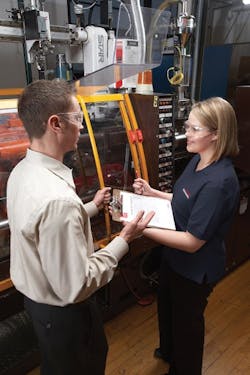Rockwell Automation Makes Risk Assessment Pay
In today’s competitive environment, savvy companies understand that risk assessment is also a key to improving overall productivity. A risk assessment—conducted by a qualified risk assessment specialist—serves to safeguard machines and help improve productivity as it defines the mitigating techniques that reduce risk to an acceptable level.
“There’s no question that a documented risk assessment provides valuable information and can potentially lead to improved productivity and the discovery of process improvements,” says Michael J. Duta, PE, manager, Rockwell Automation Safety Services. “When properly conducted, a risk assessment will identify the hazards of a machine as well as the safety circuit architecture that needs to be applied to safeguard it.”
According to Duta, risk assessment is crucial as companies work to build safety into the design of a production system or remove hazards from existing installations. By leveraging the experience of the personnel who run the machines, the assessment can identify exposure to hazards that people not involved with machine operation would never consider. “A key element in risk assessment is having the right people involved in identifying hazards,” says Duta. “A second key is having the ability to identify the source of the hazard. In other words, ‘what is the root cause of the hazard to the operator?’ Once the risk level is identified, it dictates the level of safeguarding needed to mitigate the risk.”
A properly conducted risk assessment also provides direction for the development of engineered solutions that can be applied to mitigating the risks identified during the assessment process. When it comes to engineered solutions, the entire machine or portions of the machine might need to be redesigned to help reduce exposure to a hazard—an exercise that sometimes leads to unimagined process improvements. For example, according to Duta, a Rockwell Automation consultant engaged in a risk assessment of a machine being locked-out for sanitizing noted that the process involved locking the machine out, washing it down, sanitizing it, unlocking the equipment, jogging the machine, and then doing another round of sanitization. During the risk assessment, the Rockwell Automation consultant developed an alternative means of hazardous energy control and redesigned the safety system to make it possible for a jog pendant to move the machine through the sanitization process. The Rockwell Automation consultant helped eliminate the lockout/tagout task that was occurring a dozen times, per machine, every eight hours—shaving 30 minutes from the machine sanitization process. As Duta’s example illustrates, properly conducted risk assessments can lead to the discovery of alternative ways of doing business that help reduce risk while improving productivity.
A risk assessment can also lead to the development of engineered safeguards or the adoption of administrative means for helping to reduce risks, such as operator training and awareness. For instance, during the risk assessment of a printing press, a Rockwell Automation consultant noticed a discrepancy in the time it took for different operators to set up the machine for production—one operator spent 30 minutes on setup while another spent 90 minutes. Through a careful evaluation of the setup process, the Rockwell Automation consultant found several control-related tasks that could be automated. This discovery led to procedures that standardized the setup. The new setup procedures also helped reduce the time the machine was running. By doing so, Rockwell Automation helped reduce wasted ink and printed material. The new procedure was replicated across six printing lines leading to even more savings for the company.
As the printing example demonstrates, a risk assessment often leads to productivity improvements and cost savings even as it helps identify and reduce hazards. To make sure such benefits are realized, Rockwell Automation Safety Services consultants lead companies through a globally recognized risk assessment process and offer guidance on a wide range of risk reduction techniques that encompass process redesign, guarding, training, administrative requirements, and personal protection equipment.
Using a safety consultant from Rockwell Automation helps assure that the risk assessment process is managed properly and kept on track. “A good facilitator will resolve conflicts and keep the process from getting out of control,” Duta concludes. “A professional risk assessment consultant, whose full-time job it is to assess safety, will not only keep the process on track, but will help ensure that maximum benefit is gained from the assessment.”

